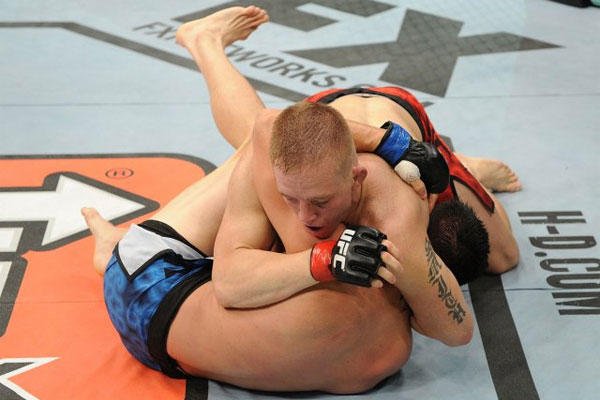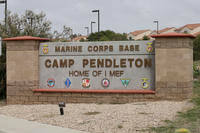FORT HOOD, Texas -- The season 16 finale of the "The Ultimate Fighter" Dec. 15 featured a Canadian squaring off against a U.S. Army Soldier stationed at Fort Hood.
After 15 grinding minutes over three rounds, III Corps' Staff Sgt. Colton Smith had his hand raised on the Las Vegas stage in front of a live TV audience, winning by unanimous decision over Mike Ricci in the welterweight bout.
Smith described the celebratory moment inside the Octagon as a culmination of all the hard work and dedication of not only himself but also his coaches and his Family.
"It's an amazing feeling of accomplishment," Smith said.
The Soldier controlled all three rounds, executing his game plan to a tee.
"The training partners that I have here at the combatives training facility, the Army guys, Tim Kennedy, Kris Perkins, Jarrod Clontz, guys like that pushing me," Smith said, "I knew it wasn't far-fetched that I'd be able to implement my game plan effectively. I knew there was a chance that his striking would give me some fits, but for the most part, the past eight weeks, I've had a game plan, and I drilled it, drilled it, drilled it.
"That's what happens when hard work, perseverance and repetition pays off," he added.
Clontz, a Fort Hood combatives instructor and the coach of the III Corps Combatives Team, coached ringside Saturday night, and he described Smith as being calm, cool and collected throughout the fight.
"We were in his corner, telling him to breathe," Clontz said. "We basically didn't have to say much (in between rounds); just reiterate what he was already doing right."
After being the aggressor for minute after minute, Smith's stamina became clear as his opponent's waned.
"I saw him fading, so I thought I'd be able to finish him in the later rounds," Smith said. "I just couldn't get the choke in.
"It seemed like he was fighting at that point more not to lose as compared to fighting to win," he added. "There's a big difference. Guys that fight not to lose, you're going to lose, but you might not get submitted. Guys that fight to win, it leaves a lot more openings. He was being extremely defensive at that point, and just wasn't going to let me finish him. I think that was his goal at that point."
Even without being able to sink his chokehold, Smith, the experienced wrestler, used his technique to remain on top and continually grind on Ricci from a dominant position.
"I've always been a leg-rider when it comes to wrestling, but this was the first fight that I had the legs in that long and didn't finish actually," he said. "I've finished a lot of my amateur and early pro fights -- every time I get the hooks in, I usually get the choke."
Perkins, the director of Fort Hood's combatives program and one of Smith's coaches, said his fighter did exactly what he had to do to win.
"He did the fight plan. It's a victory," he said. "It might not be as exciting as what people want, but until their career's on the line, they can go see if they want to make it exciting.
"In the beginning, you have to win," Perkins added. "After you have some wins in there, then you can go for exciting."
Ricci's most aggressive attempt came in the fight's final 30 seconds as he reversed position on Smith, taking his back. The Canadian attempted a desperation arm-bar submission, but Smith said he was never nervous.
"We got into a little bit of a scramble at the end, and he took my back," Smith said, describing the match's ending moments. "I knew I was fine -- I've had Tim Kennedy taking my back. I was waiting for him to start punching so that I could explode up, but he didn't start punching and instead he jumped off the front for an arm bar.
"And there's no way -- I knew he wasn't going to arm-bar me," Smith added. "And to be completely honest, if he would have straightened the arm-bar out, I wouldn't have tapped. It was too close to the end. That's what was going through my mind."
With Smith's win, both Clontz and Perkins saw it as another form of validation for the Army's combatives program.
"It shows that the Army's formula works," Perkins said. "If you open up the Army's combatives manual, it tells you to close the gap with the clinch, get in the dominant position and then finish the fight."
"It made the Fort Hood combatives program look great; it made the Army combatives program look great," Clontz added. "It made us all look good through his hard work."
Smith said his win, which earned him a guaranteed six-figure contract with the Ultimate Fighting Championship, has begun to set in, but that he's already getting ready for what's next.
"I achieved this goal, and I'm ready for the next challenge," he said.
Not knowing what the UFC has in store for him, Smith said he's not sure who his future opponents could be or when the fight would take place.
The next task for the Soldier is the completion of the Noncommissioned Officer Education System, a 30-day course he'll start in January.
"I'll get that knocked out and then get back to training, and just get ready for the next fight and representing the United States Army and III Corps the best that I can," Smith said.
As Smith's life begins to change in the days, weeks and months after being named the Ultimate Fighter -- continuing on the path he said his Lord ordained for him -- he'll remain a III Corps Soldier.
"I'd love to do whatever I can to benefit the United States Army and be a part of the team," he said. "What I'd really love to do, honestly, is spread my story around and do what I can for the Army, in that sense, on a larger scale -- speaking to young Soldiers, speaking to ROTC cadets, speaking to whoever I can speak to, to help the Army commission and the best people into the Army -- not just numbers, but the best people."





























